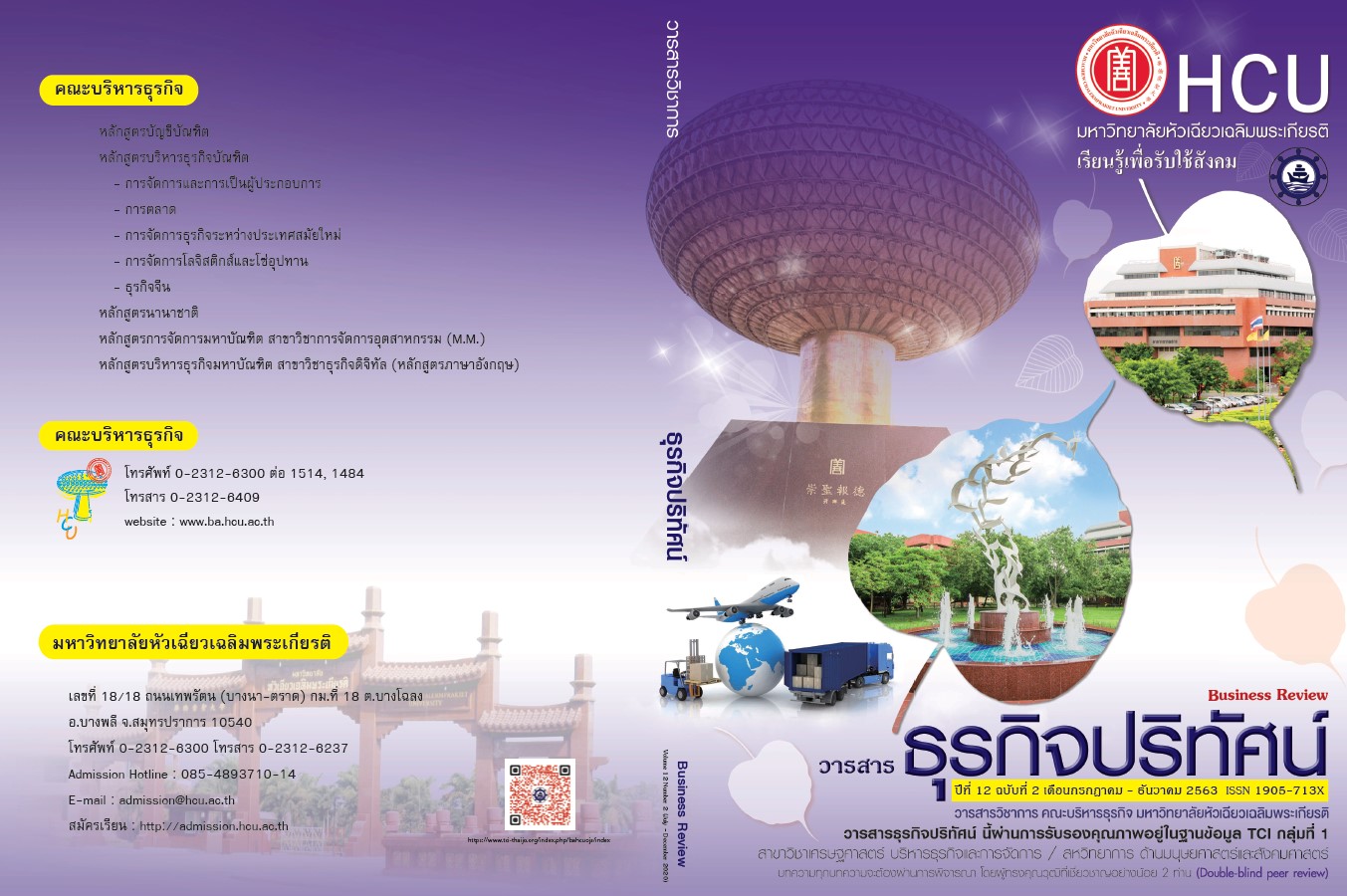Environmental Factors Affecting Consumers’ Purchase Decisions of Palm Leaf Containers in Prachuap Khiri Khan Province
Keywords:
Purchase decision, Palm leaf container, Environmental factorsAbstract
The objective of this research is to identify the environmental factors which are supporting environmental protection, drive for environmental responsibility, green product experience, environment friendliness of companies,and social appeal that influence consumers’ purchase decisions of palm leaf containers in Prachuap Khiri Khan Province. Research methodology is a quantitative survey method and questionnaire is as a tool for data collection. The population is consumers in Prachuap Khiri Khan and are selected by accidental sampling for 447 people. Percent data are analyzed using mean and standard deviation. The hypotheses are tested by multiple regression analysis.
The study indicated that the majority of participants are female and aged between 20-30 years old with bachelor’s degrees or same degree, monthly income lower than 15,000 baht or equal. Hypotheses testing showed that supporting environmental protection and green product experience has the influence toward consumers’ purchase decisions of palm leaf containers in Prachuap Khiri Khan.
References
Cegarra-Navarro, J.G., & Martinez, A.M. (2010). Managing Environmental Knowledge Through Learning Processes in Spanish Hospitality Companies. The Spanish Journal of Psychology, 13(2), 827-840.
Cheah, I., & Phau, I. (2011). Attitudes Towards Environmentally-Friendly Products –The Influence of Eco Literacy, Interpersonal Influence and Value Orientation. Marketing Intelligence and Planning, 29(5), 452-472.
Desmet, P., & Hekkert, P. (2007). framework of Product Experience. International Journal of Design, 1(1), 13-23.
Esty, D., & Winston, A. (2009). Green to Gold: How Smart Companies use Environmental Strategy to Innovate, Create Value, and Build Competitive Advantage. New York: John Wiley & Sons.
Gadenne, D., Sharma, B., Kerr, D. V., & Smith, T. (2011). The Influence of Consumers’ Environmental Beliefs and Attitudes on Energy Saving Behaviours. Energy Policy, 39(12), 7684-7694.
Geissdoerfer, M., Savaget, P., Bocken, N. M.P., & Hultink, E. J. (2017). The Circular Economy – A New Sustainability Paradigm? Journal of Cleaner Production, 143, 757-768.
Goldstein, N. J., Cialdini, R. B., & Griskevicius, V. (2008). A Room with a Viewpoint: Using Social Norms to Motivate Environmental Conservation in Hotels. Journal of Consumer Research, 35(3), 472-482.
Griskevicius, V., Tybur, J.M., & Bergh, B.V. (2010). Going Green to be Seen: Status, Reputation, and Conspicuous Conservation. Journal of Personality and Social Psychology, 98(3), 392-404.
Hair, J. F., Black, W. C., Babin, B. J., & Anderson, R. E. (2010). Multivariate Data Analysis (7th ed.). NJ: Prentice Hall.
Hamby, D. (1996). Site Remediation Techniques Supporting Environmental Restoration Activities - A Review. Science of The Total Environment, 191(3), 203-224.
Harvey, D. LD. (2018). Global Warming: The Hard Science. London: Routledge.
Hawkins, G. (2012). The Performativity of Food Packaging: Market Device, Waste Crisis and Recycling. The Sociological Review, 60(2), 66-83.
Khare, A. (2014). Consumers’ Susceptibility to Interpersonal Influence as a Determining Factor of Ecologically Conscious Behavior. Marketing Intelligence and Planning, 32(1), 2-20.
Kovács, G. (2008). Corporate Environmental Responsibility in the Supply Chain. Journal of Cleaner Production, 16(15), 1571-1578.
Kralj, D. (2008). Dialectal System Approach Supporting Environmental Innovation for Sustainable Development. Kybernetes, 37(9/10), 1542-1560.
Krejcie, R. V., & Morgan, D. W. (1970). Determining Sample Size for Research Activities. Educational and Psychological Measurement, 30, 607-610.
Kumar, P. (2014). Greening Retail: An Indian Experience. International Journal of Retail & Distribution Management, 42(7), 613-625.
Laroche, M., Bergeron, J., & Barbaro-Forleo, G. (2001). Targeting Consumers who are willing to Pay more for Environmentally Friendly Products. The Journal of Consumer Marketing, 18(6), 503-520.
Lazarus, R. J. (1992). Pursuing Environment Justice: The Distributional Effects of Environmental Protection. Northwestern University Law Review, 87, 787-857.
Lynes, J. K., & Andrachuk, M. (2008). Motivations for Corporate Social and Environmental Responsibility: A Case Study of Scandinavian Airlines. Journal of International management, 14(4), 377-390.
Oliver, J. D., & Lee, S. H. (2010). Hybrid Car Purchase Intentions: A Cross-Cultural an Analysis. Journal of Consumer Marketing, 27(2), 96-103.
Reid, T. N., Gonzalez, R. D., & Papalambros, P. Y. (2010). Quantification of Perceived Environmental Friendliness for Vehicle Silhouette Design. Journal of Mechanical Design, 132(10), 1-12.
Ringquist, E. J. (1993). Environmental Protection at the State Level: Politics and Progress in Controlling Pollution. Armonk, NY: M.E. Sharpe.
Rodríguez, F. J. G., & Cruz, Y. d. M. A. (2007). Relation between Social-Environmental Responsibility and Performance in Hotel Firms. International Journal of Hospitality Management, 26(4), 824-839.
Rokka, J., & Uusitalo, L. (2008). Preference for Green Packaging in Consumer Product Choices–Do Consumers Care? International Journal of Consumer Studies, 32(5), 516-525.
Schmolke, A., Thorbek, P., DeAngelis, D. L., & Grimm, V. (2010). Ecological Models Supporting Environmental Decision Making: A Strategy for the Future. Trends in Ecology & Evolution, 25(8), 479-486.
Vermeir, I., & Verbeke, W. (2004). Sustainable Food Consumption: Exploring the Consumer’ Attitude-Behavioral Intention’ Gap. Journal of Agricultural and Environmental Ethics, 19(2), 169-194.
Wheeler, S. M. (2013). Planning for Sustainability: Creating Livable, Equitable, and Ecological Communities (2nd ed.). New York: Routledge
Downloads
Published
How to Cite
Issue
Section
License
All articles published in the Business Administration and Management Journal Review are copyrighted by the journal.
The views and opinions expressed in each article are solely those of the individual authors and do not represent those of Huachiew Chalermprakiet University or any other faculty members. Each author is fully responsible for the content of their own article. Any errors or issues found are the sole responsibility of the respective author.




